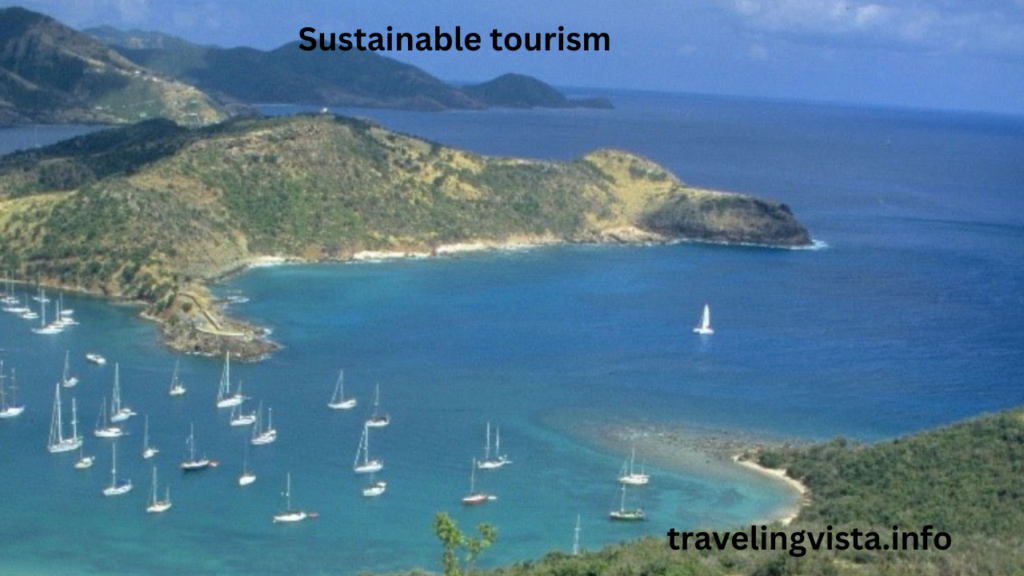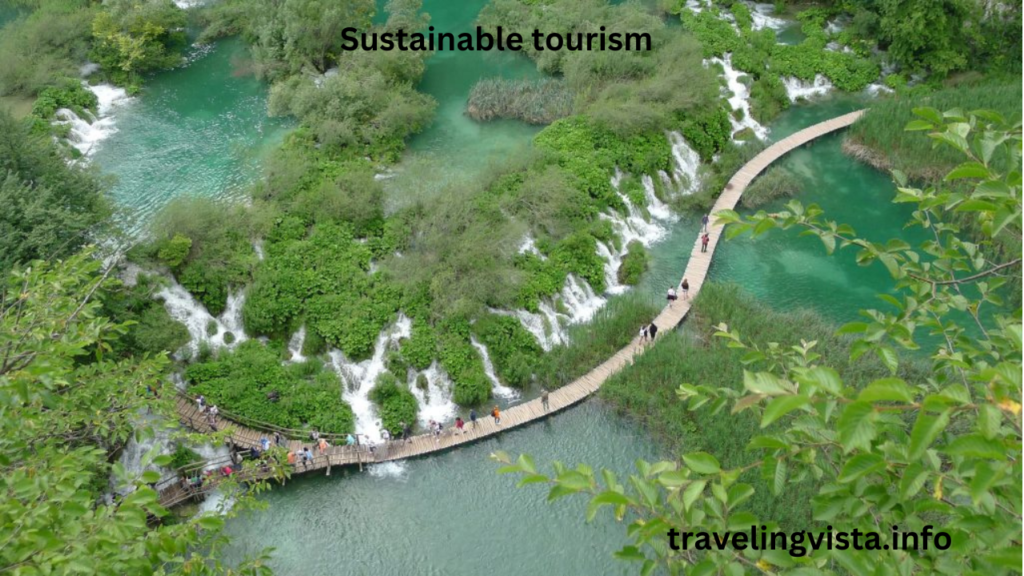It is anticipated that the size of the US market for sustainable tourism will reach US$ 263.64 million by 2033, from a projected US$ 258.1 million in 2023. Sales of sustainable tourism in the US are anticipated to grow at a noteworthy CAGR of 9.90% over the course of the forecast year.
“Tourism that addresses the needs of visitors, the industry, the environment, and host communities, taking full account of its current and future economic, social, and environmental impacts” is how the UN Environment Program and UN World Tourism Organization define sustainable tourism.

A few of the problems that have led to the demand for more ethical and sustainable tourism practices are overpopulation, the loss of socio-cultural authenticity in host communities, and the increase in greenhouse gas emissions worldwide.
In 2022, a survey of American adults revealed that more than 70% of them thought it was crucial to travel sustainably. When asked if they would choose more environmentally friendly travel options, the majority of Americans answered they would—but only provided it did not cause them any trouble.
The sustainable tourism market in the United States accounts for around 7.5% of the global market.
The preservation of resources, public and vendor education, and sound company strategies and operations that prioritize sustainable growth are some benefits linked to the tourism industry.
A rise in well-educated, sustainable travelers with average or higher annual family incomes is one of the market’s most recent trends in sustainable tourism. Planning, rules, understanding of best practices, and surveillance are necessary, even in the many aquatic and terrestrial areas that remain accessible to a large market expansion.
What are the key trends driving United States sustainable tourism market:
Organic food awareness:
As people become more conscious of organic food and its little impact on the environment, organic sustainable tourism is becoming more and more popular. The need for sustainable tourism in the US is being driven by the growing acceptance of sustainability measures. While organic food, beverages, and lodging options are not as competitive as they once were, they can give tourism operators a competitive advantage over other market participants. Sustainable tourism is still a niche business in the United States.
Willingness to visit nearby locations:
One major factor propelling the expansion of the sustainable tourism sector is consumers’ growing inclination for genuine, locally sourced experiences. This could provide visitors a sense of the customs and cultures found in particular areas of the United States, encouraging them to learn more about the area. Additionally, it’s anticipated that this will raise interest in sustainable travel to the US.
Getting some fresh air:
Over the course of the forecast period, it is expected that demand for sustainable tourism in the United States for outdoor recreation activities like backpacking and animal observation would increase. The wealthy are generally the main drivers of the sustainable tourism sector, which includes anything from captivating riverbanks to lush woods. The passengers are completely rejuvenated as a result of maintaining their connection to nature.

Community that takes initiative:
Increases in ecotourism in certain areas are the result of state, local, and tourism bureau marketing efforts. These efforts include websites and tourist pamphlets placed in welcome centers along highways, hotels, and airports. Thus, it is anticipated that up until 2033, the United States would see a sharp increase in the use of sustainable tourism.
Knowledge of the sustainable use of resources in the United States:
Furthermore, it is projected that the market for sustainable tourism would expand as a result of public concern over resource deterioration brought on by improper maintenance or overuse of well-known sustainable tourism destinations.
Gain in disposable income:
As people’s disposable income increases globally, there will likely be a greater demand for sustainable tourism in the United States. Spending on recreational activities in general and eco-friendly travel are therefore expected to increase.
Willingness to make a local reservation:
A growing number of hotels are implementing eco-friendly building materials and sustainable methods from the ground up. Plus, they’re trying to maintain these facilities in the middle of the natural world. This guarantees that only environmentally friendly techniques are used for everything from eating to enjoying a variety of other leisure activities. As a result, demand for sustainable travel to the United States may rise.
Reduced ecological impact:
Eating only food grown nearby and dining at nearby restaurants is a key component of sustainable development. This might contribute to the growth of the affected area, which would improve the conditions there. This makes the objective of sustainable development much more attainable.
Challenges in the sustainable tourism market in the US:
Lack of infrastructure:
Bad air, rail, or road connectivity to a variety of sustainable tourist areas in the United States is one of the primary issues facing the ecotourism industry.
The monopoly of a small number of tour guides and the demand for more trained and qualified tour guides exacerbate the risk of taking advantage of tourists.
Insufficient funds:
It is simpler to maintain and upgrade recreational facilities and infrastructure and offer visitors high-quality service when there are staffing and financial limitations.

Ignorance:
Sustainable tourism is not as well-known as many other types of tourism; therefore, it may be losing out on opportunities that could yield significant profits. The demand for sustainable travel to the US is being negatively impacted by this.
How government initiatives boost sustainable tourism market in US:
The government takes into account a number of crucial aspects to increase the share of the US sustainable tourism market, including supply and demand, marketing, accessibility, accommodation costs, transportation concerns, community support, and reliance on tourism.
The government is aware that community involvement is essential to the design and development of
sustainable tourism policy in the United States. Federal and state land management agencies recognize the benefits of encouraging stakeholders to have a thorough awareness of the possible socioeconomic and environmental ramifications of sustainable tourist operations. For example, the National Training Center of the Bureau of Land Management offers its staff exclusive courses on community relations.
An additional example is the National Park Service’s “Rivers and Trails” program, which aims to assist localities in planning outdoor leisure activities that involve the preservation of open space, the construction of trails and greenways, and the conservation of rivers. Additionally, local communities are being contacted by the government.

Category wise insights:
It is expected that the sustainable tourism market in the United States will be dominated by individuals between the ages of 26 and 35, and that this trend will continue. This age group has a higher propensity for travel and a voracious appetite for trying out new activities like surfing, kayaking, scuba diving, and water rafting. This age group also favors visiting well-known locations according to destination ratings, which is probably going to increase demand in the US.
Due to its affordability, package travel currently commands the largest portion of the US sustainable tourism market—44.1%. In addition, lodging, transportation, and attraction fees are all included in packaged travel, which reduces costs to a single point of contact with significant discounts and deals.
However, women also make up a sizeable portion of the market as awareness of sustainable development grows. Women now hold a larger portion of the market, and analysts predict that future consumer orientation-based market dynamics may change. This is because women today are more aware of their surroundings and frequently provide all of the household income, putting them in a position to make decisions on their own.
FAQS:
What are the United States sustainable tourism market CAGR for 2023?
The CAGR for the US sustainable tourism market is 9.90% until 2033.
How big will the United States Sustainable Tourism Market by 2030?
The CAGR for the US sustainable tourism market is 9.90% until 2033.
How key players are developing the United States sustainable tourism market?
By funding sustainable tourism projects, major stakeholders in the US sustainable tourism business are growing it.
Which country has the best sustainable tourism?
- Bhutan
- Scotland
- Rwanda
- Slovenia
- Finland
- New Zealand
- Barbados
Which country is leading in sustainable tourism?
Most people agree that Sweden is one of the world’s most sustainable nations. By measuring a nation’s environmental performance using metrics including air quality, greenhouse gas emissions, and waste management, the Environmental Performance Index (EPI) has consistently placed it among the top nations.
Conclusion:
The UN Environment Program and UN World Tourism Organization define sustainable tourism as “tourist that addresses the needs of visitors, the industry, the environment, and host communities, taking full account of its current and future economic, social, and environmental impacts.”
A few of the problems that have led to the demand for more ethical and sustainable tourism practices are overpopulation, the loss of socio-cultural authenticity in host communities, and the increase in greenhouse gas emissions worldwide.
In a poll conducted in 2022 among American adults, more over 70% of participants said that environmentally friendly travel was crucial. These are some government and other factors that effect sustainable tourism in United States. I hope it will beneficial for you. In case of any difficulty contact us through our link on website.

